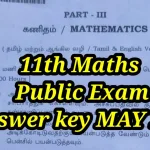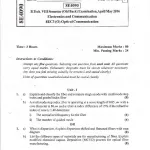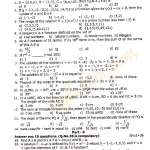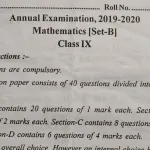Sample Division Questions and Answers:
-
If you have 48 apples and put them equally in 4 baskets, how many apples are in each basket? Answer: 12 apples
-
There are 36 candies to share equally among 9 children. How many candies does each child get? Answer: 4 candies
-
A baker baked 63 cookies and wants to pack them equally into 7 boxes. How many cookies will each box contain? Answer: 9 cookies
-
You have 80 books and you want to arrange them equally on 10 shelves. How many books will each shelf hold? Answer: 8 books
-
There are 45 stickers and 5 friends. How many stickers does each friend get if they share them equally? Answer: 9 stickers
-
A farm has 56 chickens and they are put into 8 coops equally. How many chickens are in each coop? Answer: 7 chickens
-
You divide 72 pencils equally among 8 students. How many pencils does each student receive? Answer: 9 pencils
-
If a teacher divides 60 minutes of class time into 5 equal lessons, how long is each lesson? Answer: 12 minutes
-
There are 98 grapes and 7 children. How many grapes does each child get if divided equally? Answer: 14 grapes
-
A book has 120 pages and you want to read it in 10 days, reading the same number of pages each day. How many pages should you read each day? Answer: 12 pages
-
A gardener plants 81 flowers into 9 flower beds evenly. How many flowers does each bed get? Answer: 9 flowers
-
You have 100 stickers and decide to give them equally to 10 friends. How many stickers will each friend receive? Answer: 10 stickers
-
There are 72 sports cards divided equally among 9 children. How many cards does each child get? Answer: 8 cards
-
A lady has 54 beads and wants to make necklaces, putting 6 beads on each. How many necklaces can she make? Answer: 9 necklaces
-
You have 32 balloons to give out equally to 8 kids at a party. How many balloons does each kid get? Answer: 4 balloons
-
A box contains 66 oranges, and they need to be packed in 6 smaller boxes equally. How many oranges will each box contain? Answer: 11 oranges
-
There are 90 eggs and 10 boxes. How many eggs will you put in each box if you distribute them equally? Answer: 9 eggs
-
You have 44 marbles and want to share them with 4 friends so that everyone gets the same amount. How many marbles does each friend get? Answer: 11 marbles
-
A pack of 75 glow sticks needs to be divided equally among 15 children at a party. How many glow sticks does each child get? Answer: 5 glow sticks
-
There are 63 pieces of candy to be shared equally among 7 bags. How many pieces of candy are in each bag? Answer: 9 pieces of candy
-
If a mother has 56 pieces of chocolate and she gives them out equally to her 8 children, how many pieces does each child get? Answer: 7 pieces
-
You are organizing 100 race medals into 5 boxes. How many medals will go into each box? Answer: 20 medals
-
A classroom has 36 students and the teacher has 4 prizes. If she gives the prizes to students in equal groups, how many students are in each group? Answer: 9 students
-
A store has 84 bottles of water and wants to place them equally into 12 crates. How many bottles will each crate contain? Answer: 7 bottles
-
If a baker uses 120 eggs to make cakes and each cake requires 8 eggs, how many cakes can the baker make? Answer: 15 cakes
-
There are 132 pages in a booklet, and it is divided into 12 sections equally. How many pages are in each section? Answer: 11 pages
-
You have 200 seeds and 10 planting trays. If you distribute the seeds equally among the trays, how many seeds are in each tray? Answer: 20 seeds
-
There are 30 students in a class, and the teacher wants to divide them into groups of 5. How many groups will there be? Answer: 6 groups
-
If you have 64 crayons and want to give them equally to 8 children, how many crayons does each child get? Answer: 8 crayons
-
A toy factory produces 90 toy cars and divides them equally among 9 stores. How many toy cars does each store receive? Answer: 10 cars
-
There are 49 books in a library, and they need to be arranged on 7 shelves equally. How many books will each shelf have? Answer: 7 books
-
You have 42 party favors to give out at your birthday party and 7 guests. How many favors does each guest get? Answer: 6 favors
-
A pizzeria has 80 slices of pizza and wants to divide them equally among 10 tables. How many slices will each table get? Answer: 8 slices
-
A group of 24 children is divided into teams of 3 for a game. How many teams can be formed? Answer: 8 teams
-
If a class of 36 students needs to be divided into groups of 6, how many groups will there be? Answer: 6 groups
-
There are 63 people at a concert and 7 rows of seats. How many people will sit in each row? Answer: 9 people
-
A farmer has 72 apples and wants to put them into 9 baskets equally. How many apples will each basket contain? Answer: 8 apples
-
You have 27 water bottles and 3 backpacks. If you distribute the bottles equally among the backpacks, how many bottles does each backpack get? Answer: 9 bottles
-
There are 50 cookies and 5 children. How many cookies does each child get if they are shared equally? Answer: 10 cookies
-
A class has 44 students and they need to form teams of 4 for a project. How many teams can they make? Answer: 11 teams
-
If there are 100 seeds and 4 garden plots, how many seeds go into each plot if distributed equally? Answer: 25 seeds
-
A group has 84 stickers and divides them among 12 children. How many stickers does each child get? Answer: 7 stickers
-
You have 60 chocolates and 6 friends. How many chocolates does each friend get if you share them equally? Answer: 10 chocolates
-
A book has 98 pages and is divided into chapters of 7 pages each. How many chapters are there? Answer: 14 chapters
-
If there are 55 students and they need to be divided into groups of 5, how many groups will there be? Answer: 11 groups
-
A building has 90 apartments and 10 floors. How many apartments are on each floor if they are distributed equally? Answer: 9 apartments
-
You have 72 gummy bears and 8 friends. How many gummy bears does each friend get if they share them equally? Answer: 9 gummy bears
-
A teacher has 63 markers and wants to distribute them among 9 students equally. How many markers does each student receive? Answer: 7 markers
-
There are 40 pencils and 5 pencil boxes. How many pencils will you put in each box if you distribute them equally? Answer: 8 pencils
-
You have 110 marbles and 10 jars. How many marbles do you put in each jar if they are divided equally? Answer: 11 marbles
Top Indian Math Books for Class 4 Division Practice
-
Math Magic by NCERT – This book by the National Council of Educational Research and Training includes clear examples and a variety of problems that help students grasp basic division concepts.
-
Composite Mathematics by S.K. Gupta and Anubhuti Gangal – Published by S. Chand Publishing, this book features step-by-step problem-solving techniques, focusing on making division intuitive and accessible.
-
New Enjoying Mathematics by Aashalata Badami – Oxford University Press publishes this engaging book which includes a mix of word problems and straight numerical division questions to build strong foundational skills.
-
Maths Buzz by Anita Sood – Navneet Education Limited offers this interactive book which incorporates puzzles and games alongside traditional division exercises, making learning more interactive.
-
Primary Mathematics by Priti Shankar – Allied Publishers presents this book, which is known for its systematic approach to mathematics, including detailed sections on division that encourage conceptual understanding.
-
Mathematics Today by PK Mittal – Published by Bloomsbury India, this book provides a comprehensive set of division problems, including context-based questions that relate to real-world scenarios, enhancing practical understanding.
-
Goyal Brothers Prakashan Mathematics for Class 4 – This book focuses on systematic learning and includes a range of exercises from simple division to more complex problems involving remainder concepts.
-
Scholar’s Mathematics by Sheela Aggarwal – Scholar Publishing House produces this book, emphasizing problem-solving skills with a variety of division questions, from simple to challenging.
-
ICSE Mathematics for Primary School by Neena Sinha – G. Ram Books presents a structured and graded set of problems, specifically designed for ICSE students, featuring both straightforward division and compound problems.
-
MathsWiz by Anita Sood – Published by Pearson Education, this book uses a visual and interactive approach to division, including the use of charts and pictures to aid understanding.
-
Mental Maths by Kajal Sengupta – Frank Educational Aids offers this book to enhance computational skills, including a significant number of division exercises designed to be solved mentally to improve speed and accuracy.
-
Golden Mathematics by Kanchan Upreti – Published by New Age International, this book provides a balanced mix of theory and practice in division, suitable for reinforcing classroom learning at home.
-
Conquer Mathematics by Kunal Gupta – Pitambar Publishing includes varied types of division problems including word problems, helping students apply mathematical concepts in daily life situations.
-
Ratna Sagar Mathematics for Young Learners by Meera Tandon – This book includes creative division exercises and games that make learning division fun and engaging for young learners.
-
Brilliant’s Primary Mathematics by Josephine Selvaraj – Brilliant Publishers provides a thorough exploration of division, including the use of division in practical applications like sharing and grouping.
-
Targeting Mathematics by Saroja Sundararajan – Orient BlackSwan ensures a deep understanding of division through repeated practice and reinforcement, ideal for mastering the basics at a young age.
-
Step-by-Step Mathematics by Neetu Hooda – This Arya Publishing Company book is designed to build confidence with incremental difficulty levels in division, perfect for gradual learning progression.
-
My Friendly Maths Book by Sunita Arora – S. Chand Publishing delivers a friendly approach to division with colorful illustrations and simple language to help clarify concepts.
-
Active Teach Universal Mathematics by Lata Thergaonkar – Pearson Education provides a digital and interactive component, offering a variety of division scenarios that cater to different learning styles.
-
Fundamentals of Mathematics by A. Kumar – Vikas Publishing House offers exercises that cover all aspects of division, ensuring students can handle different division tasks effectively.
Understanding Division Questions for Class 4: Building a Strong Foundation in Math
Division is a critical arithmetic operation that signifies an advanced stage in a child’s mathematical development, particularly for students in class 4. Mastering division not only enhances their numerical skills but also prepares them for more complex mathematical concepts. This article aims to explore effective strategies and insights for making division both understandable and enjoyable for young learners.
Why Division Matters in Class 4
By the time students reach class 4, they have usually mastered addition and subtraction, and have a good understanding of multiplication. Division, often considered the inverse of multiplication, rounds out their basic arithmetic skills. It is essential for problem-solving and helps in understanding fractions, ratios, and percentages later on. Therefore, solidifying a child’s division skills at this stage is crucial for their future academic success in math.
Engaging Division Questions
To make learning division engaging, it’s important to present questions that are relatable and fun. Word problems that involve scenarios from everyday life can be particularly effective. For example, asking how many candies are to be shared among friends or how many pages a student needs to read daily to finish a book encourages practical understanding.
Incorporating Visual Aids
Children often understand concepts better when they are visualized. Using objects like blocks or beads to demonstrate division, or drawing pictures to represent problems, can make abstract concepts tangible. Visual aids help students grasp the idea of dividing a whole into equal parts, which is the essence of division.
Step-by-Step Approaches
A systematic approach to solving division questions can significantly boost a child’s confidence. Start with simple divisions, such as dividing by 2 or 10, which are easier and help build confidence. Gradually move to more challenging numbers. Encourage students to check their work by multiplying the quotient by the divisor to see if it equals the dividend. This not only confirms their answer but reinforces their multiplication skills.
Technology and Tools
Leveraging educational technology can also enhance learning. There are numerous apps and online platforms with interactive division games and quizzes that make learning exciting. These tools provide immediate feedback, allowing students to learn at their own pace and encouraging them to improve.
Practice Makes Perfect
Consistent practice is key to mastering division. Daily practice sessions, using a variety of problems, help reinforce concepts and improve speed and accuracy. Encourage students to explain their reasoning as this deepens their understanding and helps them remember the steps involved.
Peer Learning
Learning in groups or with a partner can be particularly effective. It allows students to share strategies and solve problems together, which can make learning less intimidating and more of a collaborative effort. This approach also helps students learn from each other’s mistakes and successes.
By integrating these methods into teaching division to class 4 students, educators and parents can help them not only understand division better but also develop a lifelong appreciation for math.
FAQ for Division Questions for Class 4
-
What is division in math?
-
Division is one of the four basic operations in arithmetic, where you divide a number (dividend) into equal parts (divisors) to find out how many times the divisor fits into the dividend.
-
-
Why is learning division important in class 4?
-
Division helps students in problem-solving, understanding fractions, and preparing for more complex math concepts. It is a fundamental skill that supports academic growth in mathematics.
-
-
How can parents help their child with division at home?
-
Parents can help by providing practice problems, using everyday scenarios to create word problems, and using visual aids like coins or blocks to demonstrate division.
-
-
What are some tips for making division fun?
-
Incorporate games, interactive apps, or even cooking and baking activities where measuring and dividing ingredients can be used to teach division.
-
-
How often should students practice division?
-
Regular practice is recommended. Daily sessions, even if short, can help reinforce skills and improve a student’s comfort with division tasks.
-
-
Can students use calculators for division in class 4?
-
While calculators might be used occasionally, it’s important for class 4 students to first understand and practice division manually to build a strong foundation in mental arithmetic.
-
Latest Posts
- Step-by-step guide to download and apply for jee mains admit card 202
- Comprehensive 2025 government holidays and recruitment details for job seekers
- JEE Mains Admit Card 2025: Your Step-by-Step Guide to Downloading the Hall Ticket
- Everything You Need to Know About 2025 Government Holidays Recruitment
- Comprehensive Guide to rrb d group recruitment 2025 – Eligibility, Vacancies, and Application
- Detailed guide to nps trust recruitment 2025 vacancies, eligibility and apply process
- Comprehensive guide to hpcl recruitment 2025 notification, vacancies, and application process
- ignou bed admission 2025 complete recruitment guide with eligibility and process
- Comprehensive Guide to Indian Army Agniveer Recruitment 2025 Notification and Jobs
- Everything You Must Know About CBSE Board Exams 2025 Changes & New Rules






